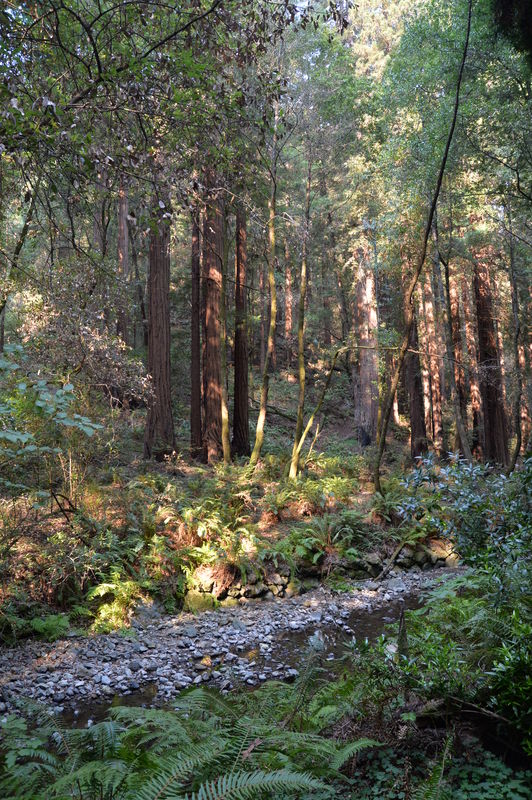Does anyone know what happened here
Sep 6, 2017 14:24:12 #
A slightly different framing made the camera see a bright spot as important rather than the shady spot it saw in the first image, so it chose the wrong ISO. It's good digital "film" is so cheap!
Sep 6, 2017 14:31:29 #
Best I can tell is that the metering system didn't get the exposure right in the second shot. From EXIF data, the camera was set to auto-area AF mode. In this mode, the camera selects the location of the subject within the frame. The scenes' selected subject (e.g., its color) is part of the matrix metering algorithm. For the first shot, the camera selected a point directly on the large tree to the left of the person. The camera's primary focus point was on this tree and at about the person's knee level. For the second shot, the camera selected a point between the person and the same tree at a point just beside her feet as the primary focus point. That point was quite a bit lighter than the tree and, perhaps, contributed to the underexposure of the second image. Also, another change between the scenes is that, the person (or camera perspective) moved to the right leaving a larger area between the tree and the person in the second shot as compared to the first. With the second shot using this brighter area between that person and the tree as the subject, this likely also contributed to a difference in metering. In fact, while most of the second shot is dark, the subject area between the person and the tree is not terribly underexposed. I believe that you would have had more consistent exposure results if you had not let the camera select the subject focus point. Instead, a single point AF mode (manually set over the person's face) is probably a better approach.
Sep 6, 2017 14:33:29 #
cambriaman wrote:
A slightly different framing made the camera see a bright spot as important rather than the shady spot it saw in the first image, so it chose the wrong ISO. It's good digital "film" is so cheap!
That was my conclusion also.
Sep 6, 2017 15:08:28 #
rfcoakley wrote:
Best I can tell is that the metering system didn't... (show quote)
I think your answer about the perils of auto-area AF is probably the best answer so far. As you point out, since the exposure is tied to the subject focus point selected, there was enough of a difference in EV between these two focus points to account for the different ISO values. I tried auto-area once with a brand new D500, just to see how it worked, and after 10 sec of abject horror, I decided this was not for me. Thinking about it still sends a shutter up my aperture.
Sep 6, 2017 15:10:14 #
did some experimenting with auto-ISO in manual mode. Had a scene with a dark object beside window. Without changing the scene at all, I simply changed focus point. When focused at a brighter point over the window, the ISO was set a lot lower than when focused on the dark object beside the window. I also found that it is possible to use exposure lock with the focus point set to one point and then change focus to a different point. In this case, the auto-ISO function set the ISO corresponding to the original focus point before exposure lock. This, however, doesn't seem to be very useful since, if you go to the trouble of locking in exposure for the scene before final focus, you might as well manually set the ISO associated with the locked exposure.
Sep 6, 2017 15:11:10 #
Yes, sometimes auto iso doesn't work great. The cool thing I've noticed about auto iso is the camera can choose increments that are not available to me when I set it manually. When I set it manually, mine starts at 100 and each setting after that is double, like 200, 400, 800 and the like. What I've noticed about auto is that the camera has the liberty to choose a "just right" setting like 160 or 240 or 320 etc. My P900 is wonderfully judicious about iso keeping it surprisingly low in a variety of situations. My Canon T5i not so much. Seems to be much more light hungry. It makes me wonder if I missed that part of the owner's manual that allows me to dial in non standard iso values. I agree with Steve, your incident seems like a freak occurrence.
Sep 6, 2017 15:13:17 #
Leitz
Loc: Solms
We've all had these exposure problems when first starting out. They have a way of disappearing as we gain experience and learn to properly use our camera's meter.
Sep 6, 2017 15:17:04 #
tomcat wrote:
...I tried auto-area once with a brand new D500, just to see how it worked, and after 10 sec of abject horror, I decided this was not for me. Thinking about it still sends a shutter up my aperture.
That helps me understand why I'm glad that I use Canon and not Nikon. That entire imagery makes my aperture pucker!



Sep 6, 2017 15:18:39 #
Leitz wrote:
We've all had these exposure problems when first starting out. They have a way of disappearing as we gain experience and learn to properly use our camera's meter.
I didn't start out!
Sep 6, 2017 15:22:02 #
ppage wrote:
Yes, sometimes auto iso doesn't work great. The c... (show quote)
If you want more control over ISO settings on a T5i/700D, you might want to consider Magic Lantern: http://www.magiclantern.fm/
I use it on a T2i / T3i, no problems, very stable, and very useful.
Sep 6, 2017 15:28:02 #
Peterff wrote:
Ha! And no it was the jet stream taking an abnorm... (show quote)
Thanks for recommending Muir Wood. It's great there. Matrix meter sucks but only for color negative film for digital it works great. Auto ISO doesn't suck either this is the first time it acted up.
Other pics in the wood are just fine. These are some shot SOOC.



Sep 6, 2017 15:30:24 #
BebuLamar wrote:
Thanks but my question is not involving getting correct exposure but rather why the meter changed its reading so drastically with the scene very close to the same.
MURPHY
Sep 6, 2017 15:46:22 #
Peterff wrote:
Yep, I got that too, although the version I remember is the somewhat less reverential one, "Does the Pope s*** in the woods!" - with apologies to devout Catholics on the forum!
Now that you mention it, "Is the Pope Catholic? Does a bear s*** in the woods?" I think that was the entire saying.
Sep 6, 2017 15:54:18 #
BebuLamar wrote:
Thanks for recommending Muir Wood. It's great there. Matrix meter sucks but only for color negative film for digital it works great. Auto ISO doesn't suck either this is the first time it acted up.
Other pics in the wood are just fine. These are some shot SOOC.
Other pics in the wood are just fine. These are some shot SOOC.
Nice. Please take my comment in the context of any automation can occasionally be fooled, even if it is generally more reliable than human control. I use matrix metering quite a lot, also auto ISO, but I still feel that your specific shots posted had lighting dynamics that were challenging for any situation, under either human or computer control. However, with a Nikon Df and raw images the exposure difference is not significant. You can get good results from both exposures.
Mostly, I'm glad that you had a good time, and I'm glad that you enjoyed Muir Woods. It is a local treasure, and a great place to spend a quiet day with a camera and a decent tripod.
Take good care!
Sep 6, 2017 15:55:21 #
rfcoakley wrote:
... The camera's primary focus point was on this tree and at about the person's knee level. For the second shot, the camera selected a point between the person and the same tree at a point just beside her feet as the primary focus point. ...
I had not even considered focus points but as you point out, if the camera is selecting different points on which to focus it would likely select different points for the matrix metering.
This also brings to mind the practice of auto exposure locking and auto focus locking followed by re-framing. How would anyone expect a relatively dumb camera to juggle all of that and get it right.
Of course my primary interest is in generally static scenes such as this one as well as more ordinary landscape, still life or casual photography. For my choice of images I don't really need auto anything including autofocus which is fine since many of the cameras I use don't have meters, autofocus or vibration reduction.
Some of these auto functions may be essential for action photography but, like vibration reduction, they can backfire and create more problems and questions than they solve.
I prefer to keep things simple. I decide where to focus and I decide how to expose, whether the camera likes it or not.
PS: Before someone objects to my use of the term "focus points", there is of course only one focus distance because the camera cannot focus on more than one distance. It can, however, take several points into consideration in determining that distance just as it can take into consideration the different brightness levels for different points during matrix metering to calculate the exposure.
If you want to reply, then register here. Registration is free and your account is created instantly, so you can post right away.





